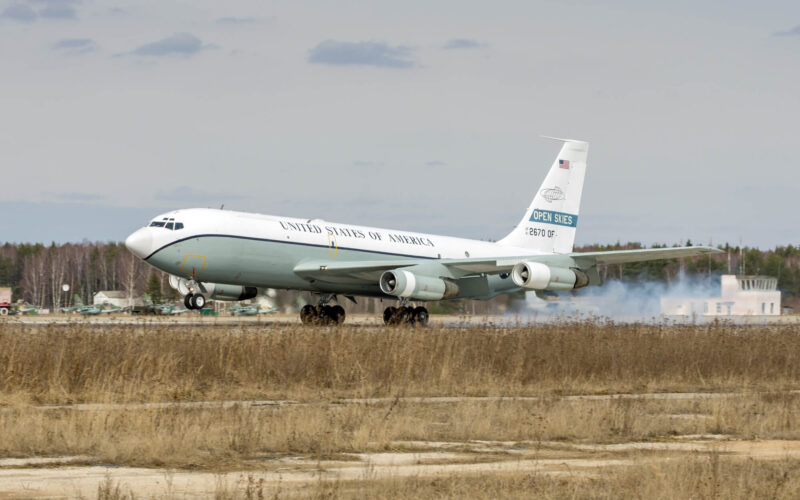The United States is unlikely to rejoin the Open Skies Treaty, which allows mutual aerial monitoring of military movements and strategic installations of the signatory countries, according to a diplomatic note seen by Defense News. US President Joe Biden’s administration is concerned that reintegrating the organization would send the “wrong message” to Russia. As a consequence, the US Air Force is due to retire in the coming months its two Boeing OC-135B Open Skies aircraft that were being used to carry out the treaty’s observation flights.
On November 22, 2020, President Donald Trump’s administration had officially withdrawn the United States from the treaty, citing “repeated violations from Russia.” While during his campaign Biden pronounced himself against his predecessor’s decision, his administration has not shown intention to reserve the process since his inauguration in January 2021.
On January 15, 2021, Russia also announced its intention to withdraw from the Open Skies Treaty. In a plenary meeting of the Open Skies Consultative Commission on February 22, 2021, Konstantin Gavrilov, the head of the Russian delegation, announced that the domestic withdrawal procedure of the Russian Federation from the Open Skies Treaty would be done by the end of summer 2021.
From the moment each party officially notify the other depositories of their withdrawal, they have 6 months to reverse the process. The United States now appears unlikely to do so, as the Biden administration is reportedly concerned that rejoining the treaty would “undermine” its position on arms control.
Among the alleged violations of the treaty, one point of contention was the fact that Russia refused for the treaty to apply to the Georgian territories of Abkhazia and South Ossetia, which the Kremlin recognizes as independent countries and thus outside of the Treaty’s jurisdiction. Another issue concerns the overflight time of the Kaliningrad enclave, above which Russia unilaterally imposed a limit of 500 kilometers as to not disturb civilian flights too long.
“While we recognize that Russia’s Open Skies violations are not of the same magnitude as its material breach of the INF [Intermediate-Range Nuclear Forces – ed. note] Treaty, they are part of a pattern of Russian disregard for international commitments — in arms control and beyond — that raises questions about Russia’s readiness to participate cooperatively in a confidence-building regime,” the US note reads.
Thus, on April 3, 2021, the USAF announced that the two Boeing OC-135B observation planes specifically equipped for the application of the treaty would be retired and sent to the 309th Aerospace Maintenance and Regeneration Group (AMARG), colloquially known as the Boneyard, in Davis-Monthan Air Force Base in Arizona, United States, “in the next couple of months.”
The OC-135B is based on the WC-135B Constant Phoenix weather reconnaissance aircraft. It can hold up to 35 observers from the signatory treaties.It is equipped with 3 KS-87E cameras for low-altitude observation, and one KA-91C panoramic camera for flights at 35,000 feet (10,000 meters). A Data Recording and Annotation System processes the position, altitude, and time of each shot.
The first aircraft entered operational service in October 1993. The fleet is operated by the 45th Reconnaissance Squadron of the 55th Wing, based at Offutt Air Force Base in Nebraska, United States.
What is the Treaty on Open Skies?
Initially negotiated between the members of NATO and of the Warsaw Pact, the Treaty on Open Skies was signed in 1992 in Helsinki, Finland. However, it was only ratified nine years later by Russia and came into effect on January 1, 2002.
State parties are Belarus, Belgium, Bosnia and Herzegovina, Bulgaria, Canada, Croatia, the Czech Republic, Denmark, Estonia, Finland, France, the Republic of Georgia, Germany, Greece, Hungary, Iceland, Italy, Latvia, Lithuania, Luxembourg, the Netherlands, Norway, Poland, Portugal, Romania, Russia, Slovakia, Slovenia, Spain, Sweden, Turkey, Ukraine, the United Kingdom, and, for now, the United States. Kyrgyzstan is also a signatory of the treaty but it has yet to be ratified. The countries are all members of the Organization for Security and Co-operation in Europe (OSCE). One of the purposes of those flights is to observe military movements and make sure arms limitation measures are enforced.
Each country must accept a number of observation flights, the “passive quota” and is able to carry out as many as it received, the “active quota”. A 72-hour notice before an observation flight must be communicated to the authorities of the observed country, and the other members of the treaty. Once the flight is carried out, the data collected is available to all signatories.
Asked about the importance of the Treaty, the French Armed Forces General Staff told AeroTime News that “as a guarantee of transparency, it stems from the common will of state parties to create security and confidence on the European continent”.
The flight has to be carried out by an “unarmed, fixed-wing aircraft” equipped with “agreed sensors”. These sensors include optical panoramic and framing cameras, video cameras with real-time display, all with limited resolutions defined by the Treaty. While provisions to use sideways-looking synthetic aperture radars and infra-red line-scanning devices exist, none of the aircraft specifically equipped for the application of the treaty have any onboard.

